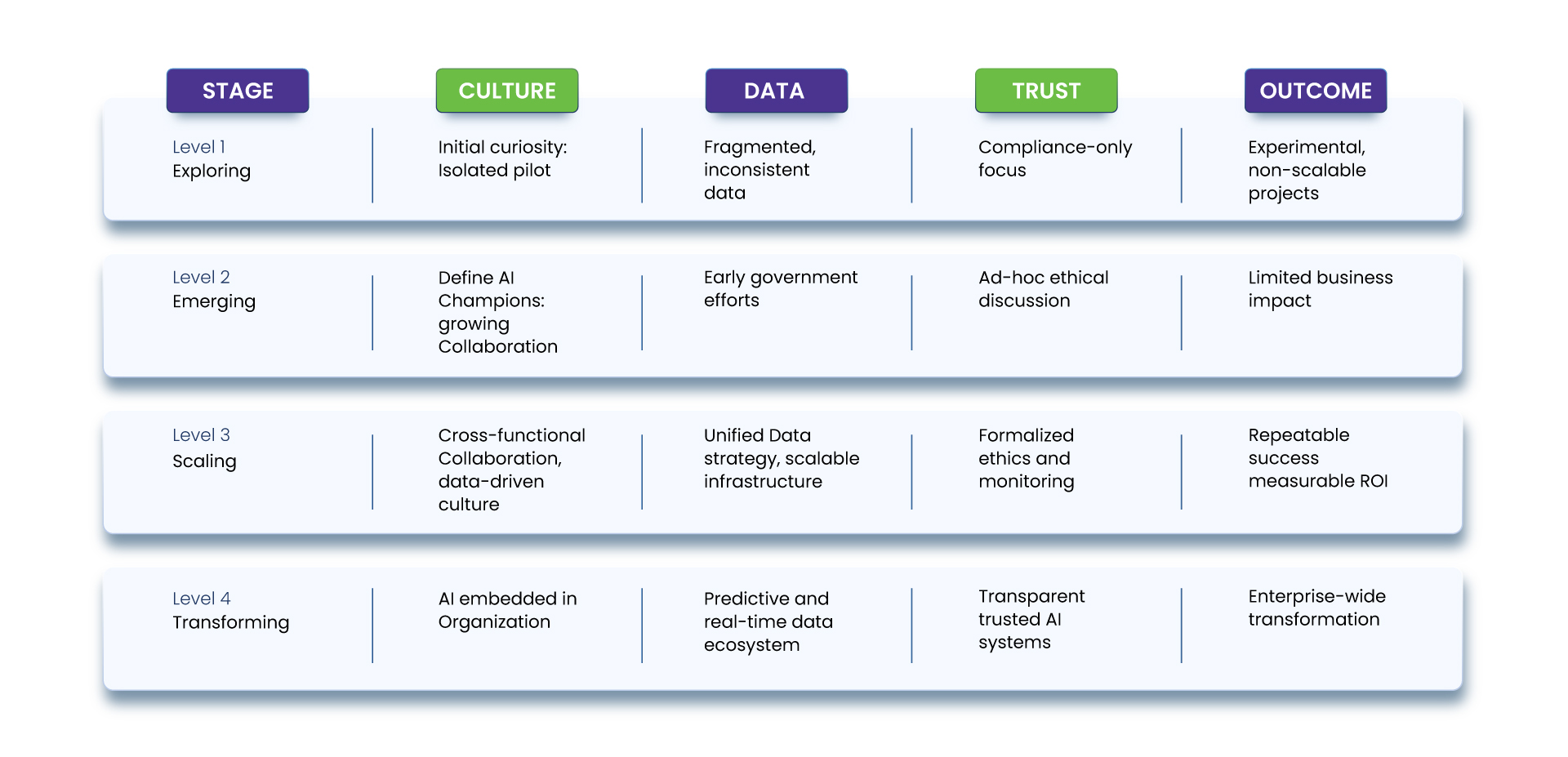Artificial Intelligence (AI) is no longer a futuristic concept it is reshaping how organizations innovate, compete, and grow. Across industries, companies are racing to deploy AI-driven solutions that enhance efficiency, enable personalization, and deliver strategic advantage. Yet, while enthusiasm for AI adoption is high, many organizations rush into implementation without ensuring foundational readiness. The result is often fragmented pilots, unreliable insights, and initiatives that fail to scale.
True AI success is not achieved by technology alone but through building readiness across three critical dimensions Culture, Data, and Trust. Together, these form the backbone of an AI-ready organization capable of sustainable and scalable transformation. This article outlines practical principles, real-world examples, and a maturity model to help leaders assess and strengthen their AI foundations.
Why AI Readiness Matters
AI implementation is not just about deploying advanced models; it is about enabling the ecosystem that allows those models to deliver real business value.
One of the biggest barriers to AI adoption is the presence of silos where IT, data, and business functions operate independently. Without alignment, AI projects lose direction and scalability. Data, the very fuel that powers AI, is often scattered, poorly governed, or unreliable. Without trusted data, AI models fail to deliver credible or actionable insights.
A lack of collaboration also impedes cultural readiness. Building an AI-ready organization requires not only robust data systems but also fostering shared understanding and accountability across team.
For instance, Walmart a global retail giant faced major challenges when early iterations of its AI-driven demand forecasting system produced inaccurate sales predictions across multiple regions. The inaccuracies, often exceeding 15–20% variance, were traced back to fragmented data pipelines and inconsistent product hierarchies across markets. The company responded by overhauling its data governance and migrating to a unified data Lakehouse on Azure, improving forecast accuracy and reducing stock-outs by up to 30% (Source: Microsoft Azure Customer Story, 2022).
Similarly, Capital One, one of the largest U.S. banks, paused the rollout of an AI-powered customer service chatbot after discovering that model training data contained sensitive customer details. This prompted a company-wide re-evaluation of its AI ethics and data privacy framework, integrating explainability tools and human-in-the-loop oversight before resuming deployment (Source: Forbes, 2023).
These real-world examples illustrate how lack of readiness whether in data quality, governance, or ethical safeguards can delay or derail even the most advanced AI initiatives.

The Three Pillars of an AI-Ready Foundation
- Culture: From Curiosity to Collaboration
An AI-ready organization does not begin with technology it begins with people and functional alignment. A technology-first approach fails if employees are resistant, uninformed, or disconnected from the purpose of AI initiatives. An AI-ready culture fosters curiosity, collaboration, and confidence.
This begins with cross-functional collaboration that brings together IT, data, and business teams to ensure alignment between technology initiatives and organizational goals. It also requires upskilling programs that build AI literacy across all levels, helping employees understand both the potential and the limits of AI. An agile mindset is equally vital that encourages experimentation, learning from failures, and continuously improving.
A strong Culture Readiness Framework includes leadership commitment to AI strategy, clear roles for governance, and ongoing communication that builds transparency and trust.
For instance, Novartis, a global pharmaceutical leader, embarked on an AI-driven initiative to predict patient adherence and optimize clinical trial efficiency. Initially, the company struggled with inconsistent results due to fragmented patient, research, and commercial data stored across multiple legacy systems. To overcome this, Novartis partnered with Microsoft Azure to establish a unified data Lakehouse architecture and implement a robust data governance framework that standardized data definitions and lineage across regions. This transformation improved model accuracy by nearly 30% and reduced data preparation time by 50%, enabling faster, more reliable AI insights (Source: Microsoft Azure Case Study Novartis, 2022).
This real-world example illustrates why data strategy must precede AI strategy. Clean, connected, and governed data turns fragmented experimentation into scalable, enterprise-wide value ensuring AI delivers measurable impact rather than isolated success stories.
- Data: From Silos to Strategy
AI is only as good as the data behind it. Many organizations struggle because their data is fragmented, inconsistent, or inaccessible. Building a strategic data foundation ensures that AI systems can learn from accurate, unified, and meaningful information.
An AI-ready data foundation is built on four core practices: Unified data strategy, robust data strategy, robust governance framework, modern data infrastructure, Metadata and cataloguing tools.
A compelling real-world example of this is Netflix, which adopted a cloud-based data lakehouse to unify over 500 billion daily events and petabytes of content and user data across teams. By standardizing governance and integrating data lineage tracking, Netflix accelerated experimentation cycles by 30% and improved recommendation model accuracy by nearly 20% (Databricks Case Study, 2023). Similarly, in the healthcare sector, Cleveland Clinic implemented a centralized data platform on Azure to unify clinical, operational, and patient data enabling real-time analytics that improved diagnostic accuracy and reduced reporting turnaround time by 40% (Microsoft Cloud for Healthcare Report, 2023).
- Trust: From Compliance to Confidence.
As AI becomes embedded in decision-making, trust becomes non-negotiable. Without transparency and accountability, even technically sound models can face ethical, reputational, or regulatory backlash.
Trust is built through ethical frameworks that address bias, data poisoning, hallucinations, and explainability, ensuring AI operates safely and responsibly. Robust security and compliance measures aligned with data privacy laws protect sensitive information. Human-in-the-loop oversight preserves interpretability and contextual judgment in critical decisions, while continuous monitoring and drift detection help identify anomalies and prevent degradation.
A strong Trust Readiness Checklist includes documented ethics principles, built-in explainability, bias detection, and strict data access controls ensuring accountability across every stage of the AI lifecycle.
For example, Google’s “Model Cards” initiative publishes details on model training datasets some trained on up to 6 trillion tokens along with known limitations, promoting transparency and user confidence (Google AI Blog, 2022). Similarly, a University of Chicago study analysing 100 million rideshare trips found income disparities linked to opaque dispatch algorithms, emphasizing why fairness, bias detection, and explainability are central to building public trust in AI (PNAS Journal, 2021).
The AI Readiness Maturity Model
Organizations progress through multiple stages on their AI journey. The AI Readiness Maturity Model helps leaders assess their current position and define next steps for advancement.

This model provides a structured path from experimentation to transformation, ensuring that AI maturity evolves alongside organizational capability.
Moving from Readiness to Real Transformation
AI readiness is not a one-time project, it is a continuous evolution. Organizations that succeed in scaling AI share several practices:
Invest in continuous learning to build AI and data literacy across all levels.
Create feedback loops that measure both business outcomes and model performance.
Embed governance into the lifecycle into the full AI lifecycle to manage ethics, privacy, and risk.
Foster collaboration that encourages joint ownership among data, IT, and business teams.
Conclusion
As organizations race toward AI adoption, true transformation lies not in speed but in readiness cultivating the right culture, establishing strong data foundations, and embedding trust at every level. Building an AI-ready organization requires collaboration between business, data, and technology teams, along with ethical, explainable, and well-governed AI systems.
At Healthark, this philosophy is not theoretical, it is lived. Our journey with innovations like Curie, the AI-powered Intelligent Search Assistant, reflects how investing in culture, data quality, and trust-driven frameworks enables scalable transformation. By aligning people, processes, and technology under a unified AI vision, we have turned readiness into reality creating a future where AI is not just implemented, but integrated into how we think, research, and deliver impact.
Insights That Drive Impact
Healthcare is evolving faster than ever — and those who adapt are the ones who will lead the change.
Stay ahead of the curve with our in-depth insights, expert perspectives, and a strategic lens on what’s next for the industry.




